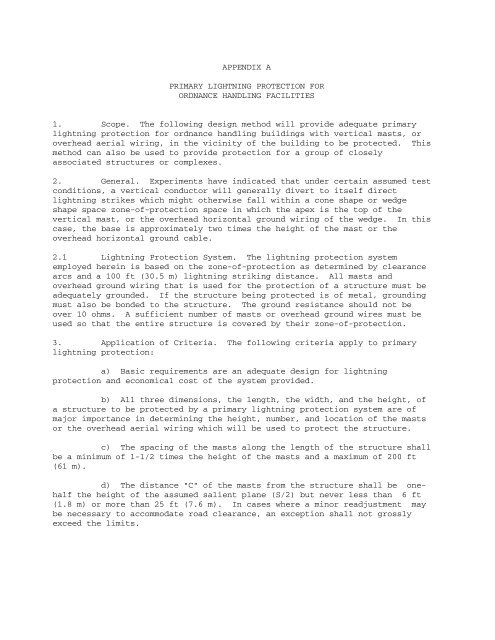NAVFAC MIL-HDBK-1004/6 Lightning Protection
NAVFAC MIL-HDBK-1004/6 Lightning Protection
NAVFAC MIL-HDBK-1004/6 Lightning Protection
You also want an ePaper? Increase the reach of your titles
YUMPU automatically turns print PDFs into web optimized ePapers that Google loves.
APPENDIX APRIMARY LIGHTNING PROTECTION FORORDNANCE HANDLING FACILITIES1. Scope. The following design method will provide adequate primarylightning protection for ordnance handling buildings with vertical masts, oroverhead aerial wiring, in the vicinity of the building to be protected. Thismethod can also be used to provide protection for a group of closelyassociated structures or complexes.2. General. Experiments have indicated that under certain assumed testconditions, a vertical conductor will generally divert to itself directlightning strikes which might otherwise fall within a cone shape or wedgeshape space zone-of-protection space in which the apex is the top of thevertical mast, or the overhead horizontal ground wiring of the wedge. In thiscase, the base is approximately two times the height of the mast or theoverhead horizontal ground cable.2.1 <strong>Lightning</strong> <strong>Protection</strong> System. The lightning protection systememployed herein is based on the zone-of-protection as determined by clearancearcs and a 100 ft (30.5 m) lightning striking distance. All masts andoverhead ground wiring that is used for the protection of a structure must beadequately grounded. If the structure being protected is of metal, groundingmust also be bonded to the structure. The ground resistance should not beover 10 ohms. A sufficient number of masts or overhead ground wires must beused so that the entire structure is covered by their zone-of-protection.3. Application of Criteria. The following criteria apply to primarylightning protection:a) Basic requirements are an adequate design for lightningprotection and economical cost of the system provided.b) All three dimensions, the length, the width, and the height, ofa structure to be protected by a primary lightning protection system are ofmajor importance in determining the height, number, and location of the mastsor the overhead aerial wiring which will be used to protect the structure.c) The spacing of the masts along the length of the structure shallbe a minimum of 1-1/2 times the height of the masts and a maximum of 200 ft(61 m).d) The distance "C" of the masts from the structure shall be onehalfthe height of the assumed salient plane (S/2) but never less than 6 ft(1.8 m) or more than 25 ft (7.6 m). In cases where a minor readjustment maybe necessary to accommodate road clearance, an exception shall not grosslyexceed the limits.
















